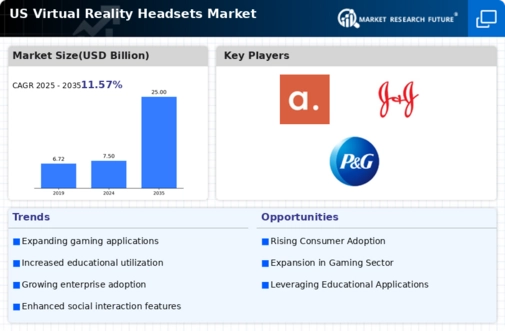Increased Investment in VR Startups
The virtual reality-headsets market is witnessing a notable increase in investment directed towards VR startups. Venture capitalists and tech giants are recognizing the potential of VR technology, leading to a surge in funding for innovative companies. In 2025, investments in VR-related startups are estimated to exceed $5 billion, indicating a strong belief in the future of this technology. This influx of capital is likely to accelerate the development of new applications and improve existing products, thereby enhancing the overall market landscape. As startups introduce novel ideas and solutions, the virtual reality-headsets market may experience a diversification of offerings, catering to various sectors such as gaming, education, and training.
Expansion of VR in Corporate Training
The virtual reality headsets market is increasingly being driven by the expansion of VR applications in corporate training. Companies are recognizing the effectiveness of VR in providing immersive training experiences that enhance learning outcomes. By simulating real-world scenarios, VR training can improve employee performance and retention rates. As of 2025, the corporate training segment is projected to account for approximately 25% of the total VR market share. This trend indicates that businesses are willing to invest in VR technology to enhance their training programs, which could lead to a substantial increase in headset sales. The virtual reality-headsets market is likely to benefit from this growing acceptance in the corporate sector.
Technological Advancements in VR Hardware
The virtual reality-headsets market is experiencing a surge due to rapid technological advancements in hardware. Innovations such as improved display resolutions, enhanced field of view, and reduced latency are making VR headsets more appealing to consumers. For instance, the introduction of OLED and LCD technologies has significantly enhanced visual fidelity, which is crucial for immersive experiences. As of 2025, the market is projected to grow at a CAGR of approximately 30%, driven by these advancements. Furthermore, the integration of lightweight materials and ergonomic designs is likely to enhance user comfort, thereby expanding the potential user base. This trend indicates that as technology continues to evolve, the virtual reality-headsets market will likely attract a broader audience, including gamers, professionals, and casual users alike.
Growing Interest in Gaming and Entertainment
The virtual reality-headsets market is significantly influenced by the growing interest in gaming and entertainment. As gaming becomes increasingly immersive, consumers are seeking out VR experiences that offer unparalleled engagement. The market for VR gaming is projected to reach $12 billion by 2026, reflecting a robust demand for high-quality VR headsets. Major gaming companies are investing heavily in VR content, which is likely to drive headset sales. Additionally, the rise of social gaming platforms that incorporate VR elements is expected to further stimulate market growth. This trend suggests that the virtual reality-headsets market will continue to thrive as more gamers seek immersive experiences that traditional gaming cannot provide.
Rising Demand for Remote Collaboration Tools
The virtual reality headsets market is experiencing growth due to the rising demand for remote collaboration tools. As organizations increasingly adopt remote work models, the need for effective virtual collaboration solutions has become paramount. VR technology offers unique capabilities for virtual meetings and collaborative projects, allowing teams to interact in immersive environments. In 2025, the market for VR collaboration tools is expected to grow by over 40%, reflecting a shift towards more engaging remote work solutions. This trend suggests that the virtual reality-headsets market will likely see an uptick in sales as businesses invest in VR headsets to facilitate better communication and teamwork among remote employees.













Leave a Comment